Linux DRM Developer's Guide
Page 1 of 54
Linux DRM Developer's Guide
Jesse Barnes
Initial version
Intel Corporation
Laurent Pinchart
Driver internals
Ideas on board SPRL
Copyright © 2008-2009, 2012 Intel Corporation, Laurent Pinchart
The contents of this file may be used under the terms of the GNU General Public License version 2 (the "GPL") as distributed in the kernel source
COPYING file.
Revision History
Revision 1.0
Added extensive documentation about driver internals.
Table of Contents
1. Introduction
2012-07-13
LP
http://landley.net/kdocs/htmldocs/drm.html
2013-4-27
�
Page 2 of 54
Linux DRM Developer's Guide
2. DRM Internals
Driver Initialization
Driver Information
Driver Load
Memory management
The Translation Table Manager (TTM)
The Graphics Execution Manager (GEM)
Mode Setting
Frame Buffer Creation
Output Polling
KMS Initialization and Cleanup
CRTCs (struct drm_crtc)
Planes (struct drm_plane)
Encoders (struct drm_encoder)
Connectors (struct drm_connector)
Cleanup
Output discovery and initialization example
Mode Setting Helper Functions
Helper Functions
CRTC Helper Operations
Encoder Helper Operations
Connector Helper Operations
Modeset Helper Functions Reference
fbdev Helper Functions Reference
Display Port Helper Functions Reference
Vertical Blanking
http://landley.net/kdocs/htmldocs/drm.html
2013-4-27
�
Linux DRM Developer's Guide
Page 3 of 54
Open/Close, File Operations and IOCTLs
Open and Close
File Operations
IOCTLs
Command submission & fencing
Suspend/Resume
DMA services
3. Userland interfaces
VBlank event handling
A. DRM Driver API
Chapter 1. Introduction
The Linux DRM layer contains code intended to support the needs of complex graphics devices, usually containing programmable pipelines well
suited to 3D graphics acceleration. Graphics drivers in the kernel may make use of DRM functions to make tasks like memory management, interrupt
handling and DMA easier, and provide a uniform interface to applications.
A note on versions: this guide covers features found in the DRM tree, including the TTM memory manager, output configuration and mode setting,
and the new vblank internals, in addition to all the regular features found in current kernels.
[Insert diagram of typical DRM stack here]
Chapter 2. DRM Internals
Table of Contents
Driver Initialization
Driver Information
Driver Load
http://landley.net/kdocs/htmldocs/drm.html
2013-4-27
�
Linux DRM Developer's Guide
Page 4 of 54
Memory management
The Translation Table Manager (TTM)
The Graphics Execution Manager (GEM)
Mode Setting
Frame Buffer Creation
Output Polling
KMS Initialization and Cleanup
CRTCs (struct drm_crtc)
Planes (struct drm_plane)
Encoders (struct drm_encoder)
Connectors (struct drm_connector)
Cleanup
Output discovery and initialization example
Mode Setting Helper Functions
Helper Functions
CRTC Helper Operations
Encoder Helper Operations
Connector Helper Operations
Modeset Helper Functions Reference
fbdev Helper Functions Reference
Display Port Helper Functions Reference
Vertical Blanking
Open/Close, File Operations and IOCTLs
Open and Close
File Operations
IOCTLs
Command submission & fencing
http://landley.net/kdocs/htmldocs/drm.html
2013-4-27
�
Linux DRM Developer's Guide
Suspend/Resume
DMA services
Page 5 of 54
This chapter documents DRM internals relevant to driver authors and developers working to add support for the latest features to existing drivers.
First, we go over some typical driver initialization requirements, like setting up command buffers, creating an initial output configuration, and
initializing core services. Subsequent sections cover core internals in more detail, providing implementation notes and examples.
The DRM layer provides several services to graphics drivers, many of them driven by the application interfaces it provides through libdrm, the library
that wraps most of the DRM ioctls. These include vblank event handling, memory management, output management, framebuffer management,
command submission & fencing, suspend/resume support, and DMA services.
Driver Initialization
At the core of every DRM driver is a drm_driver structure. Drivers typically statically initialize a drm_driver structure, and then pass it to one of the
drm_*_init() functions to register it with the DRM subsystem.
The drm_driver structure contains static information that describes the driver and features it supports, and pointers to methods that the DRM core will
call to implement the DRM API. We will first go through the drm_driver static information fields, and will then describe individual operations in
details as they get used in later sections.
Driver Information
Driver Features
Drivers inform the DRM core about their requirements and supported features by setting appropriate flags in the driver_features field. Since those
flags influence the DRM core behaviour since registration time, most of them must be set to registering the drm_driver instance.
u32 driver_features;
Driver Feature Flags
DRIVER_USE_AGP
Driver uses AGP interface, the DRM core will manage AGP resources.
http://landley.net/kdocs/htmldocs/drm.html
2013-4-27
�
Linux DRM Developer's Guide
DRIVER_REQUIRE_AGP
Page 6 of 54
Driver needs AGP interface to function. AGP initialization failure will become a fatal error.
DRIVER_USE_MTRR
Driver uses MTRR interface for mapping memory, the DRM core will manage MTRR resources. Deprecated.
DRIVER_PCI_DMA
Driver is capable of PCI DMA, mapping of PCI DMA buffers to userspace will be enabled. Deprecated.
DRIVER_SG
Driver can perform scatter/gather DMA, allocation and mapping of scatter/gather buffers will be enabled. Deprecated.
DRIVER_HAVE_DMA
Driver supports DMA, the userspace DMA API will be supported. Deprecated.
DRIVER_HAVE_IRQ, DRIVER_IRQ_SHARED
DRIVER_HAVE_IRQ indicates whether the driver has an IRQ handler. The DRM core will automatically register an interrupt handler when
the flag is set. DRIVER_IRQ_SHARED indicates whether the device & handler support shared IRQs (note that this is required of PCI drivers).
DRIVER_IRQ_VBL
Unused. Deprecated.
DRIVER_DMA_QUEUE
Should be set if the driver queues DMA requests and completes them asynchronously. Deprecated.
DRIVER_FB_DMA
Driver supports DMA to/from the framebuffer, mapping of frambuffer DMA buffers to userspace will be supported. Deprecated.
DRIVER_IRQ_VBL2
http://landley.net/kdocs/htmldocs/drm.html
2013-4-27
�
Page 7 of 54
Linux DRM Developer's Guide
Unused. Deprecated.
DRIVER_GEM
Driver use the GEM memory manager.
DRIVER_MODESET
Driver supports mode setting interfaces (KMS).
DRIVER_PRIME
Driver implements DRM PRIME buffer sharing.
Major, Minor and Patchlevel
int major;
int minor;
int patchlevel;
The DRM core identifies driver versions by a major, minor and patch level triplet. The information is printed to the kernel log at initialization time
and passed to userspace through the DRM_IOCTL_VERSION ioctl.
The major and minor numbers are also used to verify the requested driver API version passed to DRM_IOCTL_SET_VERSION. When the driver
API changes between minor versions, applications can call DRM_IOCTL_SET_VERSION to select a specific version of the API. If the requested
major isn't equal to the driver major, or the requested minor is larger than the driver minor, the DRM_IOCTL_SET_VERSION call will return an
error. Otherwise the driver's set_version() method will be called with the requested version.
Name, Description and Date
char *name;
char *desc;
char *date;
The driver name is printed to the kernel log at initialization time, used for IRQ registration and passed to userspace through
DRM_IOCTL_VERSION.
http://landley.net/kdocs/htmldocs/drm.html
2013-4-27
�
Linux DRM Developer's Guide
Page 8 of 54
The driver description is a purely informative string passed to userspace through the DRM_IOCTL_VERSION ioctl and otherwise unused by the
kernel.
The driver date, formatted as YYYYMMDD, is meant to identify the date of the latest modification to the driver. However, as most drivers fail to
update it, its value is mostly useless. The DRM core prints it to the kernel log at initialization time and passes it to userspace through the
DRM_IOCTL_VERSION ioctl.
Driver Load
The load method is the driver and device initialization entry point. The method is responsible for allocating and initializing driver private data,
specifying supported performance counters, performing resource allocation and mapping (e.g. acquiring clocks, mapping registers or allocating
command buffers), initializing the memory manager (the section called “Memory management”), installing the IRQ handler (the section called “IRQ
Registration”), setting up vertical blanking handling (the section called “Vertical Blanking”), mode setting (the section called “Mode Setting”) and
initial output configuration (the section called “KMS Initialization and Cleanup”).
Note
If compatibility is a concern (e.g. with drivers converted over from User Mode Setting to Kernel Mode Setting), care must be taken to
prevent device initialization and control that is incompatible with currently active userspace drivers. For instance, if user level mode
setting drivers are in use, it would be problematic to perform output discovery & configuration at load time. Likewise, if user-level
drivers unaware of memory management are in use, memory management and command buffer setup may need to be omitted. These
requirements are driver-specific, and care needs to be taken to keep both old and new applications and libraries working.
int (*load) (struct drm_device *, unsigned long flags);
The method takes two arguments, a pointer to the newly created drm_device and flags. The flags are used to pass the driver_data field of the device
id corresponding to the device passed to drm_*_init(). Only PCI devices currently use this, USB and platform DRM drivers have their load method
called with flags to 0.
Driver Private & Performance Counters
The driver private hangs off the main drm_device structure and can be used for tracking various device-specific bits of information, like register
offsets, command buffer status, register state for suspend/resume, etc. At load time, a driver may simply allocate one and set drm_device.dev_priv
appropriately; it should be freed and drm_device.dev_priv set to NULL when the driver is unloaded.
http://landley.net/kdocs/htmldocs/drm.html
2013-4-27
�
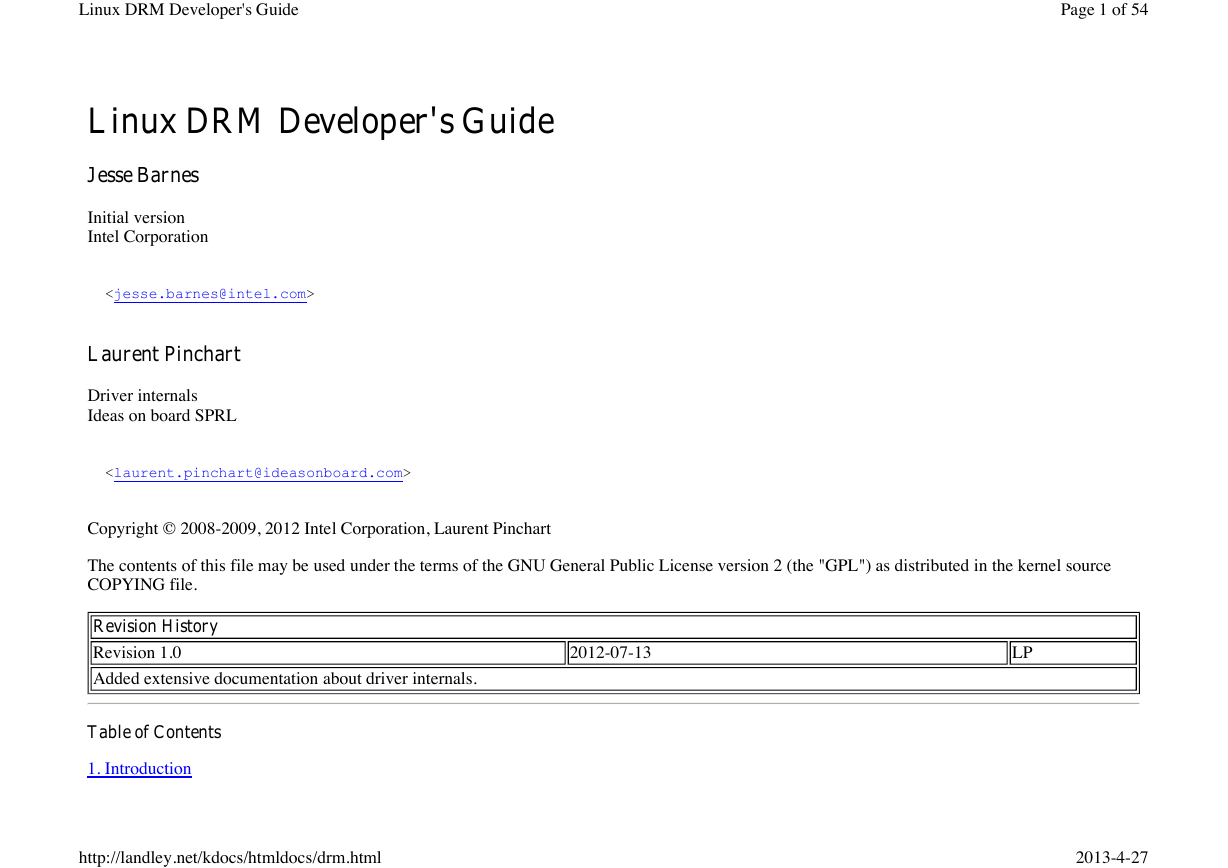
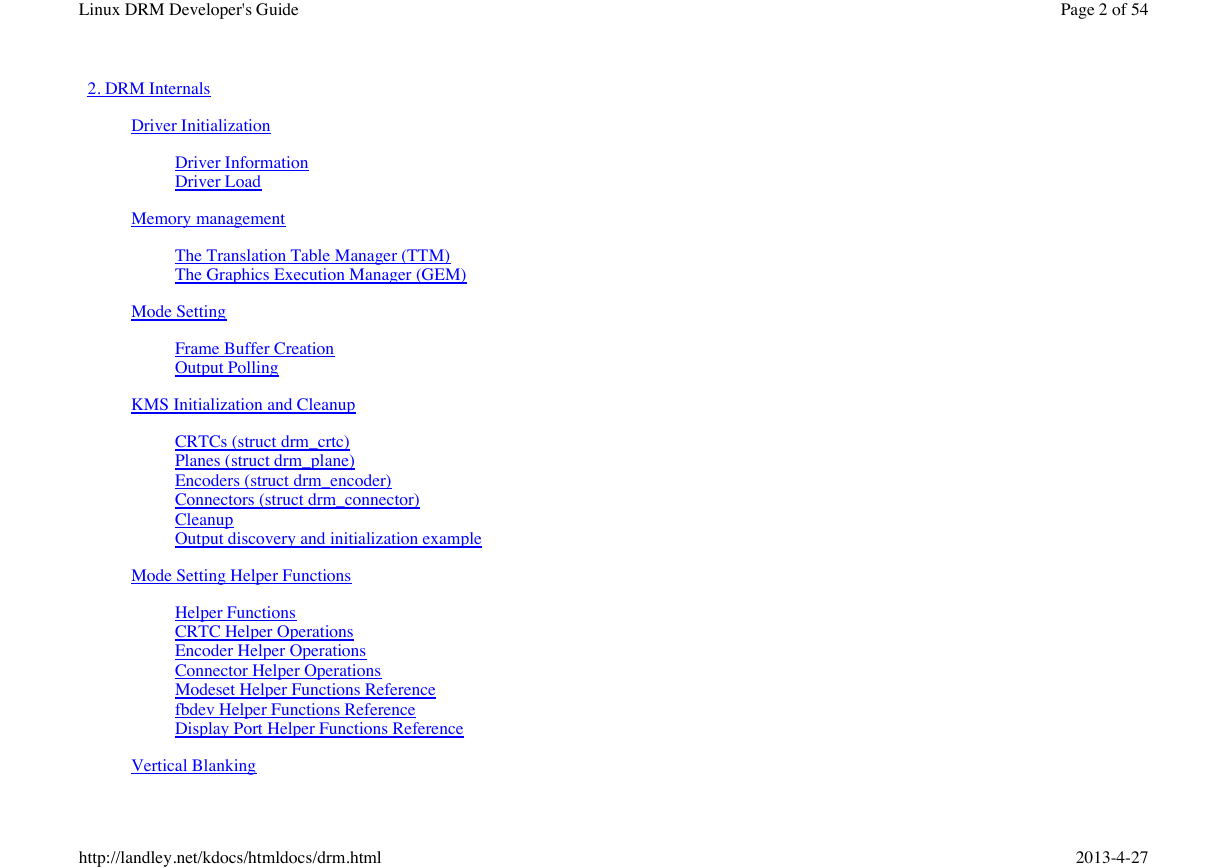
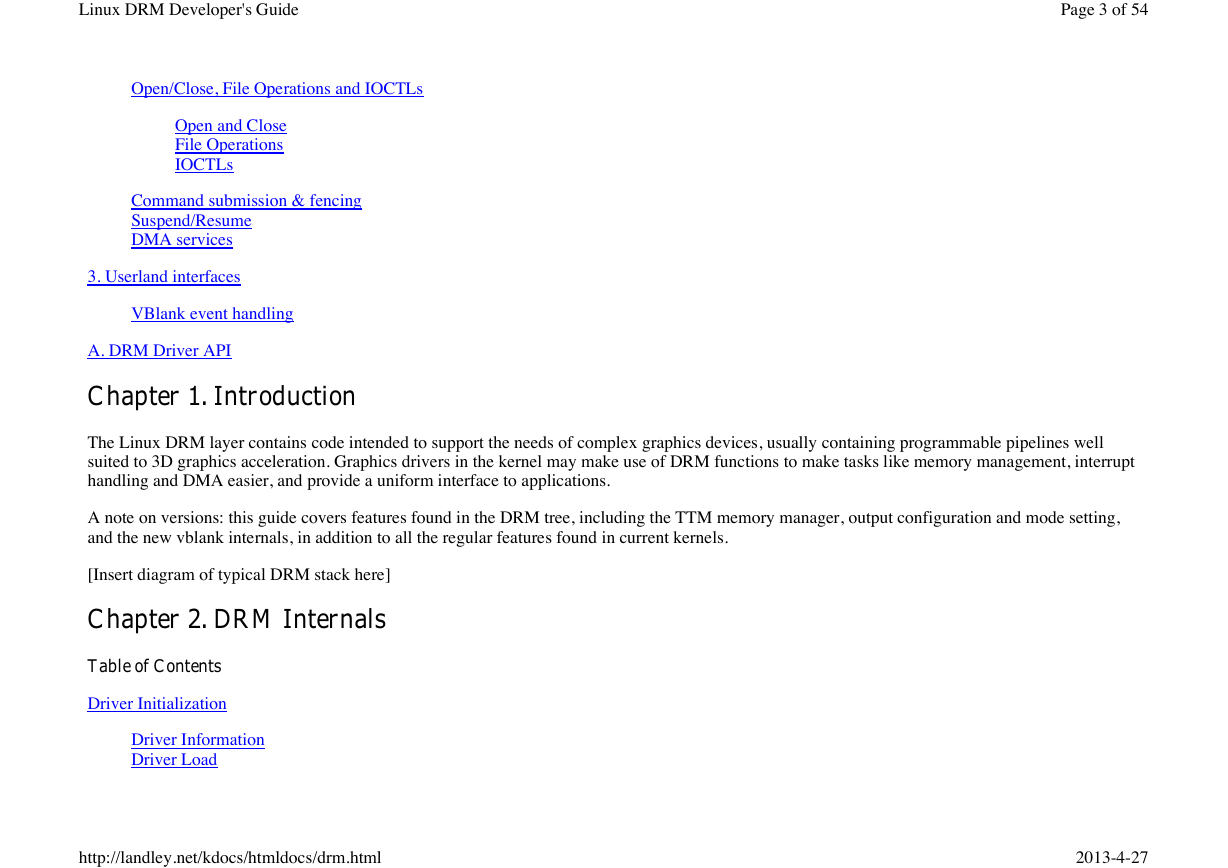
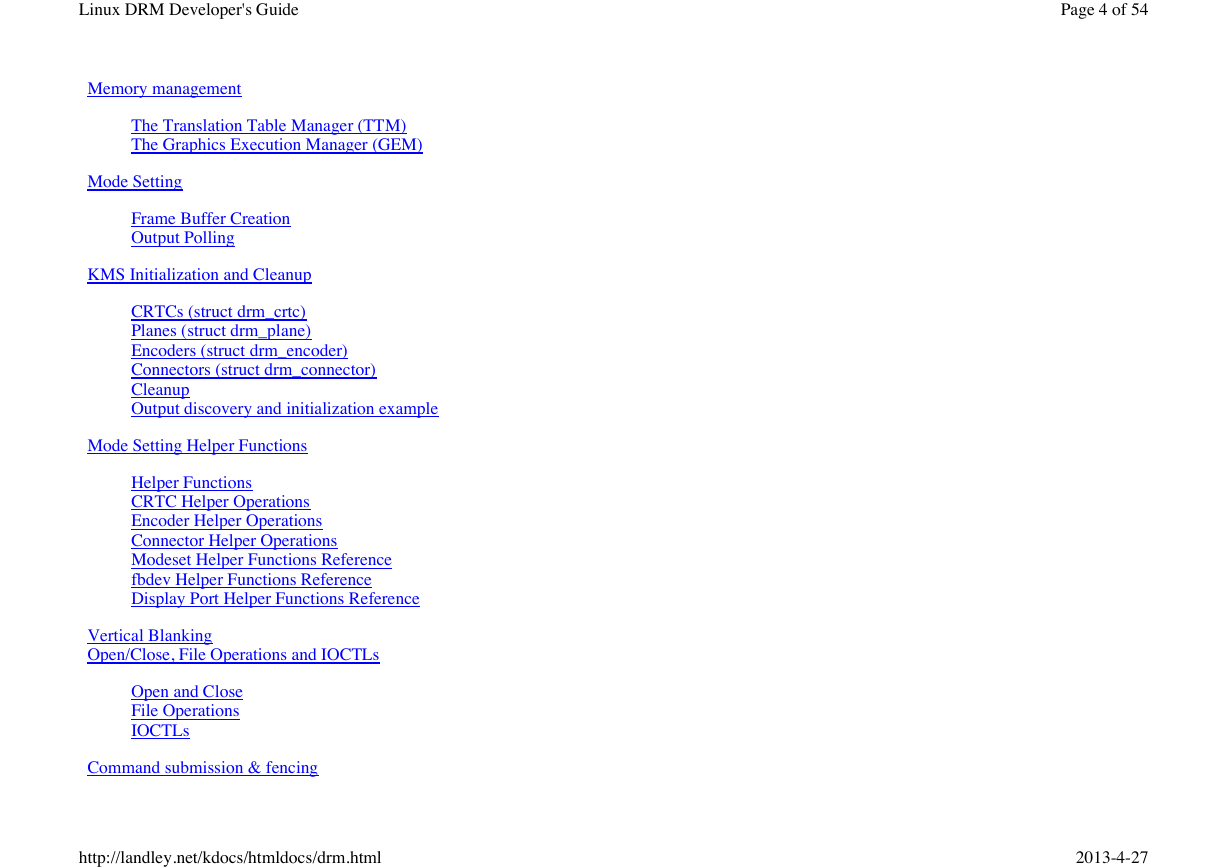



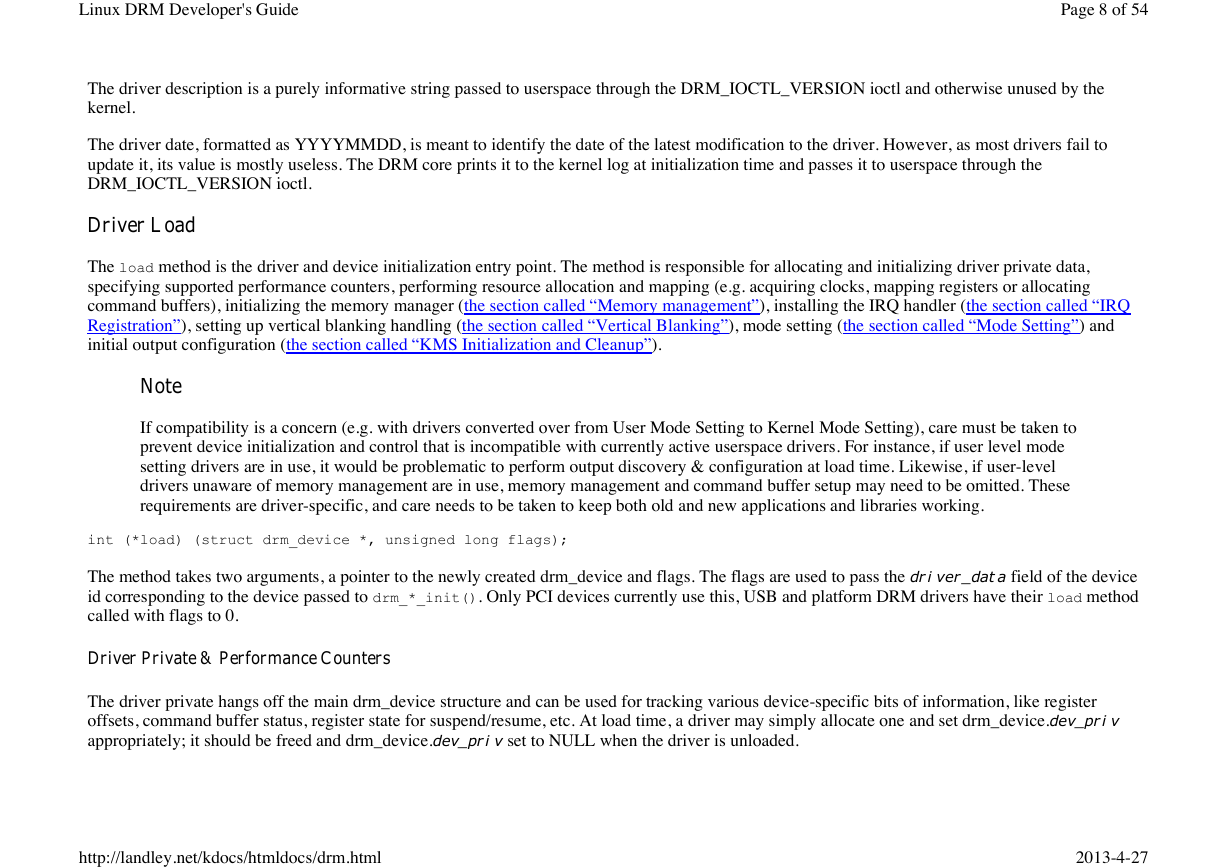








 2023年江西萍乡中考道德与法治真题及答案.doc
2023年江西萍乡中考道德与法治真题及答案.doc 2012年重庆南川中考生物真题及答案.doc
2012年重庆南川中考生物真题及答案.doc 2013年江西师范大学地理学综合及文艺理论基础考研真题.doc
2013年江西师范大学地理学综合及文艺理论基础考研真题.doc 2020年四川甘孜小升初语文真题及答案I卷.doc
2020年四川甘孜小升初语文真题及答案I卷.doc 2020年注册岩土工程师专业基础考试真题及答案.doc
2020年注册岩土工程师专业基础考试真题及答案.doc 2023-2024学年福建省厦门市九年级上学期数学月考试题及答案.doc
2023-2024学年福建省厦门市九年级上学期数学月考试题及答案.doc 2021-2022学年辽宁省沈阳市大东区九年级上学期语文期末试题及答案.doc
2021-2022学年辽宁省沈阳市大东区九年级上学期语文期末试题及答案.doc 2022-2023学年北京东城区初三第一学期物理期末试卷及答案.doc
2022-2023学年北京东城区初三第一学期物理期末试卷及答案.doc 2018上半年江西教师资格初中地理学科知识与教学能力真题及答案.doc
2018上半年江西教师资格初中地理学科知识与教学能力真题及答案.doc 2012年河北国家公务员申论考试真题及答案-省级.doc
2012年河北国家公务员申论考试真题及答案-省级.doc 2020-2021学年江苏省扬州市江都区邵樊片九年级上学期数学第一次质量检测试题及答案.doc
2020-2021学年江苏省扬州市江都区邵樊片九年级上学期数学第一次质量检测试题及答案.doc 2022下半年黑龙江教师资格证中学综合素质真题及答案.doc
2022下半年黑龙江教师资格证中学综合素质真题及答案.doc